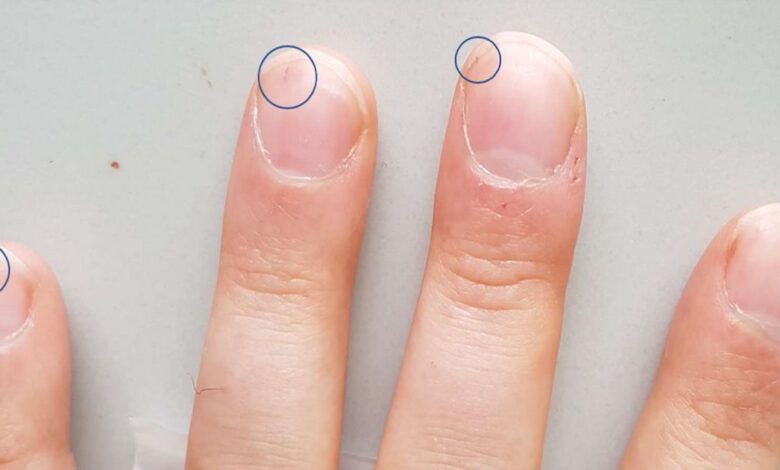Shrapnel hemorrhages (blood under nails): What's it, causes, symptoms, diagnostics, treatment, prevention

Splinter hemorrhages; Fingernail hemorrhage
What is splinter hemorrhage?
Shrapnel hemorrhages are small red or brownish streaks or dots, that appear on the nails. They are usually caused by trauma to the nail bed., but can also be caused by a number of diseases. Shrapnel hemorrhages often result from infection, such as syphilis or other bacterial or fungal infections.
Causes of splinter hemorrhages
The most common cause of splinter hemorrhage is trauma to the nail bed., eg, squeezing the nail or cutting it too deep. Other causes include insect bites or stings, fungal or bacterial infections, medical conditions, such as stroke, lupus, diabetes or heart disease, or certain medications, such as antibiotics and anticoagulants.
Shrapnel hemorrhages can occur when the heart valves become infected (endokardit). They can be caused by vascular damage due to swelling of the blood vessels (vasculitis) or tiny clots, that damage small capillaries (microemboli).
Symptoms of splinter hemorrhages
Shrapnel hemorrhages look like small red or brown lines or dots on the nail. The lines may be curved or straight and may be single., multiple, short or long. They can appear anywhere on the nail, cuticle to tip. Shrapnel hemorrhages may also be accompanied by pain or a feeling of pressure under the nail..
When to contact a healthcare professional
If you notice any splinter hemorrhages on your nails, you should see a doctor and have them evaluated by a healthcare professional. It is important to accurately diagnose the condition, to determine the best treatment.
Questions, that your doctor may ask
Your doctor may ask you a few questions, to diagnose splinter hemorrhages:
- Has the nail been injured recently??
- Have you had a history of heart or vascular disease?
- Are there any other symptoms, associated with splinter bleeding?
- Have you recently taken any antibiotics or anticoagulants?
Diagnosis of splinter hemorrhages
To diagnose splinter hemorrhages, your doctor usually starts with a physical exam and reviews your medical history.
During a physical examination, the doctor will pay special attention to the heart and circulatory system..
Laboratory studies may include:
- Blood culture
- General blood analysis (OAK)
- Erythrocyte sedimentation rate (ESR)
Besides, the following tests may be ordered:
- Chest X-ray
- Electrocardiogram ( ECG )
- Echocardiogram
Treatment of splinter hemorrhages
Treatment for splinter hemorrhages depends on the underlying cause of the condition.
If the cause is a fungal or bacterial infection, your doctor may prescribe antifungal or antibiotic medications.
If the cause is a disease, such as diabetes or lupus, your doctor may prescribe medication, to help control symptoms.
If the cause is traumatic injury, your doctor may recommend rest and light exercise to promote healing.
Treatment of splinter bleeding at home
There are several home treatments, which may help reduce the occurrence of splinter hemorrhages.
- Soak the affected area in warm water with a few drops of tea tree oil or lavender oil for 10 to 15 minutes twice a day.
- Gently massage the affected area with the almond oil mixture, vitamin E and coconut oil.
- Take a daily multivitamin supplement and drink plenty of water, to promote healing.
- Do not pick or pull on the affected nail.
Prevention of splinter bleeding
To prevent splinter hemorrhages, it is important to keep nails healthy and avoid injury to the nail bed.
- Wear gloves when cleaning, gardening or any other activity, which can damage the nail.
- Don't bite your nails or pick them.
- Trim and shape your nails, so that they put less pressure on the skin.
- Moisturize your nails regularly.
It is also important to monitor your general health and treat any diseases in a timely manner., to reduce the risk of infection. Regular exercise and a healthy diet will also help keep your nails healthy and strong..
Sources
This text meets the requirements of the medical literature, medical guidelines and current research and verified by medical professionals.
Lipner SR, Scher RK. Nail signs of systemic disease. In: Callen JP, Jorizzo JL, Zone JJ, Piette WW, Rosenbach MA, Wings RA, eds. Dermatological Signs of Systemic Disease. 5th ed. Philadelphia, PA: Elsevier; 2017:chap 44.
Tosti A. Diseases of hair and nails. In: Goldman L, Schafer AI, eds. Goldman-Cecil Medicine. 26th ed. Philadelphia, PA: Elsevier; 2020:chap 413.
Wright WF. Fever of unknown origin. In: Bennett JE, Dolin R, Blaser MJ, eds. Mandell, Douglas, and Bennett’s Principles and Practice of Infectious Diseases. 9th ed. Philadelphia, PA: Elsevier; 2020:chap 56.
